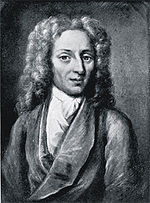- Nicolas Fatio de Duillier
-
Nicolas Fatio de Duillier (alternative names are Facio or Faccio) (26 February 1664 – 12 May 1753) was a Swiss mathematician known for his work on the zodiacal light problem, for his very close relationship with Isaac Newton, for his role in the Newton v. Leibniz calculus controversy, and for originating the "push" or "shadow" theory of gravitation. He also developed and patented a method of perforating jewels for use in clocks.
Contents
Life
Fatio was born in 1664 as the seventh of fourteen children of Jean-Baptiste and Cathérine Fatio in Basel, Switzerland. The family moved in 1672 to Duillier. In 1682 at the age of 18 Fatio travelled to Paris to perform astronomical studies under the astronomer Giovanni Domenico Cassini at the Parisian observatory. In 1686, Fatio by chance became a witness to a conspiracy aimed at William of Orange, which he helped to foil. In the same year he made the acquaintance of Jakob Bernoulli and Christiaan Huygens, with whom a particularly close cooperation was developed. Main content of their work was the calculus. In 1687 he traveled to London and made the acquaintance with John Wallis and Edward Bernard (1638-1697) and worked out a solution of the inverse tangent problem. He also was friendly connected with Gilbert Burnet, John Locke, Richard Hampden and his son John Hampden. He became a fellow of the Royal Society in 1688 on the recommendation of John Hoskyns.
He had a close relationship with Isaac Newton, and from the beginning he was impressed by Newton's gravitational theory. In 1691, he planned to prepare a new edition of Newton's Philosophiae Naturalis Principia Mathematica, but never finished it. (One of Newton's biographers [Michael White, in "Isaac Newton: The Last Sorcerer" {1997}] claimed that the relationship may have been romantic, though this is apparently based on subjective interpretations of incomplete letters.) In 1694, their relationship diminished. At this time, several letter exchanges with Gottfried Wilhelm Leibniz also took place.
In 1707, Fatio came under the influence of a fanatical religious sect, the Camisards, which ruined Fatio's reputation. He left England and took part in pilgrim journeys across Europe. After his return only a few scientific documents by him appeared. He died in 1753 near Worcester, England. After his death his Geneva compatriot Georges-Louis Le Sage tried to purchase the scientific papers of Fatio. These papers together with Le Sage's are now in the Library of the University of Geneva.
Works
Fatio's greatest scientific success was the explanation of the nature of the zodiacal light in 1684, which he attributed to particles reflecting the light of the sun. In 1688 he gave an account on the mechanical explanation of gravitation of Huygens before the Royal Society, whereby he tried to connect Huygens' theory with that of Newton. In 1690 he wrote a letter to Huygens, in which he outlined his own gravitational theory, which later was known as Le Sage's theory of gravitation. Soon after that he read its content before the Royal Society. This theory, on which he worked until his death, is based on minute particles which push gross matter to each other.
However, Fatio is most known by his important role at the Newton v. Leibniz calculus controversy, over who was the inventor of the calculus. He indirectly reproached Leibniz in a letter in 1699, that Leibniz had taken hold of an intellectual property not belonging to him and therefore started the quarrel.
To optimize the capture of solar energy, and thereby plant productivity, Fatio in 1699 suggested using a tracking mechanism which could pivot to follow the Sun. Around 1700 he and Pierre de Baufre tried to use jewels as wheel bearings in mechanical clocks. In 1705 both received a patent for that still common technology.
Popular culture
Fatio appears as a supporting character in Michael White's novel Equinox (2006).
Fatio appears as a supporting character in Neal Stephenson's novel series, The Baroque Cycle (2003-04).
Fatio appears as a supporting character in Gregory Keyes's novel series, The Age of Unreason (1998 - 2001).
References
- Wolf, R. (1862), Nicolas Fatio de Duillier, , Biographien zur Kulturgeschichte der Schweiz 4: 67–86, http://books.google.com/books?id=2kMLAAAAIAAJ&pg=PA67
- Domson, C. (1972), Nicolas Fatio de Duillier and the Prophets of London, Ayer Publishing, ISBN 0-405-13852-0
- Zehe, H. (1980), Die Gravitationstheorie des Nicolas Fatio de Duillier, Hildesheim: Gerstenberg Verlag, ISBN 3-8067-0862-2
External links
- Fatio de Duillier, N.: De la cause de la Pesanteur, 1690-1701, Bopp edition. On pp. 19-22 is an introduction by Bopp (in German). Fatio's paper starts at the end of p. 22 (in French).
- Fatio de Duillier, N.: De la Cause de la Pesanteur, 1690-1743, Gagnebin edition. For an introduction by Gagnebin, see Introduction
- Fatio de Duillier, N.: "Letters no. 2570, pp. 384-389 and 2582, pp. 407-412, 1690, Huygens Oeuvres, Vol. IX. These letters contain the first written expositions of his theory. Huygens gave an answer in letter no. 2572)
- MathPages - Nicolas Fatio and the Cause of Gravity
Categories:- Swiss mathematicians
- Fellows of the Royal Society
- Swiss Protestants
- 1664 births
- 1753 deaths
- Swiss astronomers
- Swiss inventors
- People from Basel-Stadt
Wikimedia Foundation. 2010.

